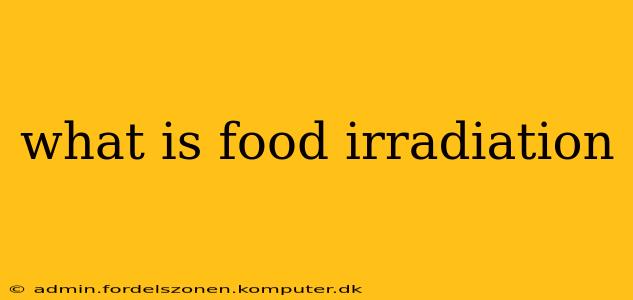Food irradiation, also known as food irradiation processing, is a technology that improves the safety and extends the shelf life of food. It involves exposing food to controlled doses of ionizing radiation, typically gamma rays, X-rays, or electron beams. This process doesn't make food radioactive; instead, it disrupts the DNA of microorganisms like bacteria, parasites, and insects, preventing them from reproducing and spoiling the food. Think of it as a powerful, precise form of pasteurization, but using radiation instead of heat.
How Does Food Irradiation Work?
The process works by using ionizing radiation to break the DNA strands of harmful microorganisms present in food. This damage prevents them from multiplying and causing spoilage or illness. The amount of radiation used is carefully controlled to achieve the desired effect without making the food unsafe to consume. Different foods require different doses depending on their composition and the specific microorganisms to be eliminated.
Types of Radiation Used in Food Irradiation:
- Gamma rays: These are emitted from radioactive isotopes like cobalt-60 or cesium-137. They are highly penetrating and can treat large quantities of food efficiently.
- X-rays: These are produced by electron accelerators and are also highly penetrating. They offer more precise control over the dose compared to gamma rays.
- Electron beams: These are produced by electron accelerators and are less penetrating than gamma rays or X-rays. They are best suited for treating foods with lower density and thickness, such as spices or surface treatments of meat.
What are the Benefits of Food Irradiation?
Food irradiation offers several significant advantages:
- Extended Shelf Life: By eliminating or significantly reducing microorganisms, irradiation can significantly extend the shelf life of many foods, reducing waste and improving food security.
- Improved Food Safety: It effectively destroys harmful bacteria, parasites (like Salmonella, E. coli, and Listeria), and insects, minimizing the risk of foodborne illnesses.
- Reduced Food Spoilage: By eliminating or inhibiting the growth of spoilage organisms, irradiation preserves the quality and freshness of food for longer periods.
- Control of Pests and Insects: Irradiation effectively controls insect infestations in grains, fruits, and other foods, preventing damage and maintaining quality.
- Delayed Ripening: In some fruits and vegetables, irradiation can delay the ripening process, extending their shelf life and maintaining their quality.
What are the Concerns Regarding Food Irradiation?
While the benefits are considerable, some concerns surround food irradiation:
- Nutritional Value: Some studies suggest that irradiation can cause minor reductions in certain vitamins and nutrients. However, the impact is generally small and often comparable to losses incurred during other food processing methods.
- Formation of New Compounds: Irradiation can lead to the formation of small amounts of new chemical compounds. However, extensive research has shown these compounds to be present in negligible quantities and pose no significant health risks.
- Consumer Acceptance: Despite scientific evidence supporting its safety, consumer acceptance of irradiated foods remains a challenge in many parts of the world due to misconceptions and negative perceptions.
Is Irradiated Food Safe to Eat?
Yes, overwhelming scientific consensus confirms that food irradiation is safe for human consumption. Major health organizations worldwide, including the World Health Organization (WHO), the Food and Agriculture Organization (FAO), and the U.S. Food and Drug Administration (FDA), have extensively reviewed the scientific evidence and concluded that irradiated food poses no health risks at approved doses. The radiation used does not make the food radioactive.
What Foods are Commonly Irradiated?
Many foods undergo irradiation, including:
- Spices and herbs: To eliminate insect infestations and extend shelf life.
- Fruits and vegetables: To control pests and extend shelf life.
- Meat and poultry: To reduce the risk of pathogens.
- Grains: To control insect infestation and extend shelf life.
How Can I Tell if Food has been Irradiated?
The FDA requires irradiated foods to be labeled with the Radura symbol, a green international symbol representing irradiation, and the statement "Treated with radiation." However, the labeling regulations vary slightly between countries, so always check the labeling of food products in your region.
Does Irradiation Affect the Taste and Texture of Food?
The effect of irradiation on taste and texture varies depending on the food and the dose of radiation used. In most cases, the changes are minimal and undetectable by the average consumer.
What is the Future of Food Irradiation?
Food irradiation continues to be a valuable technology for ensuring food safety and extending shelf life, particularly important given concerns about global food security and the increasing need to minimize food waste. Continued research aims to optimize the technology for greater efficiency and wider application across the food industry.
